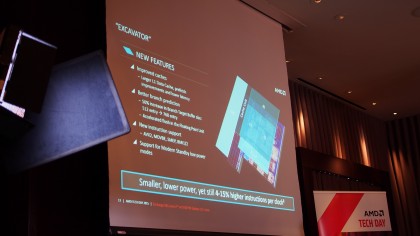AMD's new processor improves battery life, brings better graphics performance to laptops
Carrizo now known as 6th Generation APU
Performance comparison
AMD has squeezed out better performance and more battery life out of its APU with a 28nm chip design, DDR3 memory and HSA 1.0 specifications. This is quite impressive considering that rival Intel has transitioned over to a power efficient 14nm design, yet AMD claims its processor delivers stronger battery life.
General computing battery life has been improved from about 3.3 hours from the previous generation APU to 8.3 hours on the current model, according to specs released by AMD. What's even more impressive is that battery life while rendering video is also vastly superior compared to the competition. The AMD SoC is capable of 300 minutes of video playback compared to about 112 minutes on system utilizing Intel chips.

Because of HSA 1.0 compliance, graphics performance of Carrizo is superior to Intel's Core i3 CPU coupled with an Nvidia GeForce GT 740 GPU, according to Adam Kozak, AMD's product marketing manager.

In fact, Kozak claims that graphics performance is twice as powerful as the integrated graphics on Intel's Core i7 processor. AMD says that HSA 1.0 essentially gives everyone big data capabilities because of the processing power that is now available to mainstream users.
Graphics
Even though AMD is focusing on mainstream performance, gaming and entertainment at this time with the Sixth Generation A-Series, Kozak confirmed with TechRadar that the company is working to get its chips inside more mobile workstations. Mobile workstations today use either Intel's integrated graphics in a power-saving mode when not subjected to heavy workloads, with a discrete Nvidia GPU that kicks in whenever the system demands it.

To compete against these system, Kozak says that AMD's APU can work with a multi-GPU environment. With dual-graphics support, mobile workstations can be configured to take advantage of a secondary discrete AMD Radeon GPU for added performance. AMD says that it will release the APIs to give developers explicit control for more powerful multi-GPU performance. We'll have to see how this setup fares in benchmarks compared to systems utilizing Intel processors and Nvidia graphics.
Kozak says that the APU already comes with "discrete-class graphics," leveraging the power of an AMD Radeon R7 or R6 GPU inside the APU.
Sign up to the TechRadar Pro newsletter to get all the top news, opinion, features and guidance your business needs to succeed!

For business users who require a multi-monitor setup when at the office, the Sixth Generation A-Series can drive up to three simultaneous displays. In AMD's demo room comparing video performance of the A-Series to Intel's Core i-series, videos rendered with the AMD chipset appear far smoother. Videos rendered with Intel's mainstream Core i5 processor look more like a slideshow with very low framerates.
Additionally, with improved color compression on the APU for video and graphics, I found that pictures, videos and games appear brighter and more vibrant when rendered using an AMD processor compared to rival Intel's chipset at the demo station had set up.
The APU is also DirectX 12-ready.
Excavator Core
Kozak and his team says the reason the APU is able to deliver superior graphics performance is because of the chipset's low power target. This creates a virtuous cycle so the cooler the system runs, the less power it needs to cool down, which means that it can stay cool longer, while driving heavy loads. The company says this creates thermal headroom, so if needed, the chips can run use more power to run faster and exploit the thermal margin created.

The excavator core is also separated from the memory interface in AMD's thermal architecture to keep hot components away from each other.
AMD says that the Sixth Generation APU achieves a 23% area reduction in the same 28nm technology node as the prior generation APU. This leads to increased frequency for up to 39% more performance and IPC enhancements that deliver an additional 9-13% more performance.
The result is an increase in up to 55% more performance in key benchmarks, such as Cinebench, a tool that we use at TechRadar to test laptops and desktops.
Current page: Performance and graphics
Prev Page Intro and computing cores Next Page Security and innovations